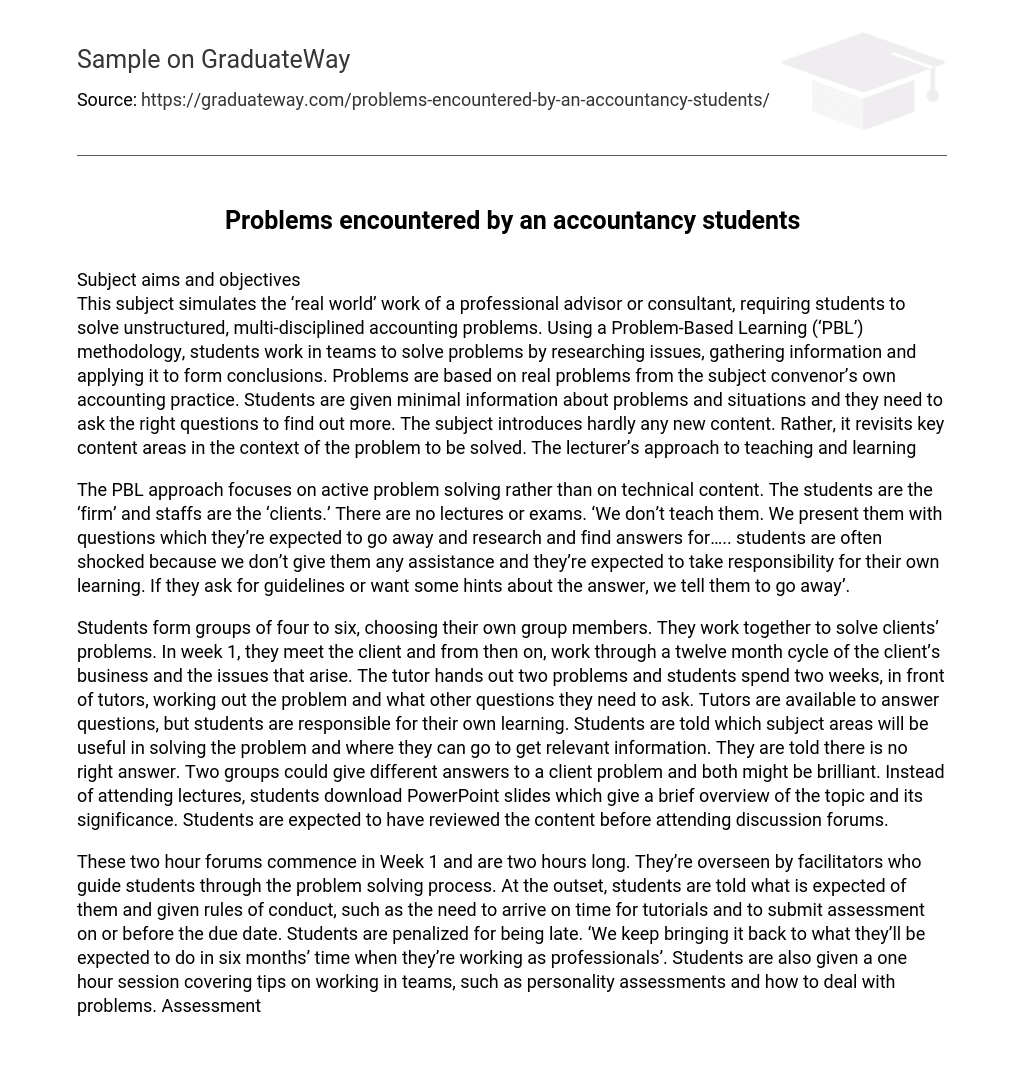Subject aims and objectives
This subject simulates the ‘real world’ work of a professional advisor or consultant, requiring students to solve unstructured, multi-disciplined accounting problems. Using a Problem-Based Learning (‘PBL’) methodology, students work in teams to solve problems by researching issues, gathering information and applying it to form conclusions. Problems are based on real problems from the subject convenor’s own accounting practice. Students are given minimal information about problems and situations and they need to ask the right questions to find out more. The subject introduces hardly any new content. Rather, it revisits key content areas in the context of the problem to be solved. The lecturer’s approach to teaching and learning
The PBL approach focuses on active problem solving rather than on technical content. The students are the ‘firm’ and staffs are the ‘clients.’ There are no lectures or exams. ‘We don’t teach them. We present them with questions which they’re expected to go away and research and find answers for….. students are often shocked because we don’t give them any assistance and they’re expected to take responsibility for their own learning. If they ask for guidelines or want some hints about the answer, we tell them to go away’.
Students form groups of four to six, choosing their own group members. They work together to solve clients’ problems. In week 1, they meet the client and from then on, work through a twelve month cycle of the client’s business and the issues that arise. The tutor hands out two problems and students spend two weeks, in front of tutors, working out the problem and what other questions they need to ask. Tutors are available to answer questions, but students are responsible for their own learning. Students are told which subject areas will be useful in solving the problem and where they can go to get relevant information. They are told there is no right answer. Two groups could give different answers to a client problem and both might be brilliant. Instead of attending lectures, students download PowerPoint slides which give a brief overview of the topic and its significance. Students are expected to have reviewed the content before attending discussion forums.
These two hour forums commence in Week 1 and are two hours long. They’re overseen by facilitators who guide students through the problem solving process. At the outset, students are told what is expected of them and given rules of conduct, such as the need to arrive on time for tutorials and to submit assessment on or before the due date. Students are penalized for being late. ‘We keep bringing it back to what they’ll be expected to do in six months’ time when they’re working as professionals’. Students are also given a one hour session covering tips on working in teams, such as personality assessments and how to deal with problems. Assessment
1. Assessment in Discussion Forums–Weight 60%
Written submission of PBL 1–each group is required to submit an answer to PBL 1 (32%) Technical correctness of PBL 2-by the end of the second discussion forum for each topic, every group presents their answer to PBL 2 to the rest of the class and is assessed on the technical correctness of their answer. (12%) Assessment of contribution-each facilitator awards a total mark out of 16 for each student’s individual participation and contribution in discussion forums throughout the semester.(16%) 2. Integrated case study (Weight 40%
Students complete an integrated case study in which they review a client’s MYOB data file and make appropriate end of year adjustments to the data file. Each student also prepares an annual report for the client and is required to compare the client’s actual financial results to budgeted data as per the business plan and comment on key performance indicators. To help students adjust to the PBL methodology, the first topic is completely formative and is called a ‘trial run’. Students are given extensive feedback as well as a ‘model answer’ and a marking scheme. Student feedback and outcomes
According to the subject convenor, students tend to be very engaged during discussion forums. ‘….in all the years the course has been running, students are offered a 10 minute break and they never take it. They keep working for the whole 2 hours’.
Students who have entered the workforce sometimes take the time to let the lecturer know how helpful the subject was. ‘I have a folder of emails from about 20 students who have entered the workforce and say things like, ‘I hated your subject when I did it and I bagged it in the LES, but now I’m working in an accounting firm and it’s unbelievable…we use what we learned in that subject every day.’ The subject convenor has also received positive feedback from practitioners. One city accounting firm wanted to pay for staff to take 20 places because they thought they would learn more from the subject than from in-house training.
Reference:
http://businesscapstones.edu.au/accounting-capstone/





